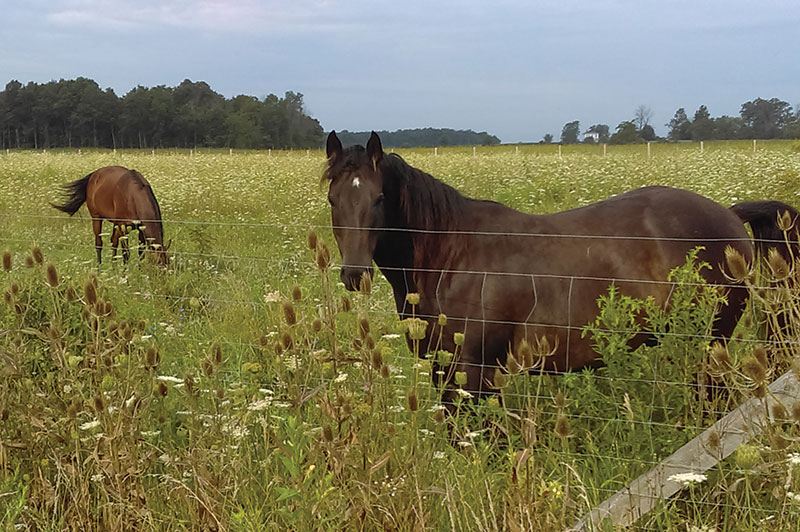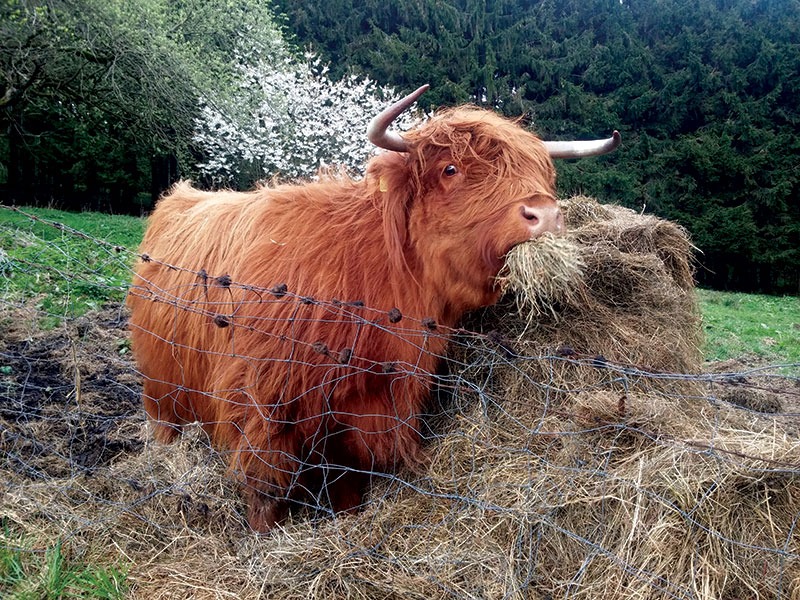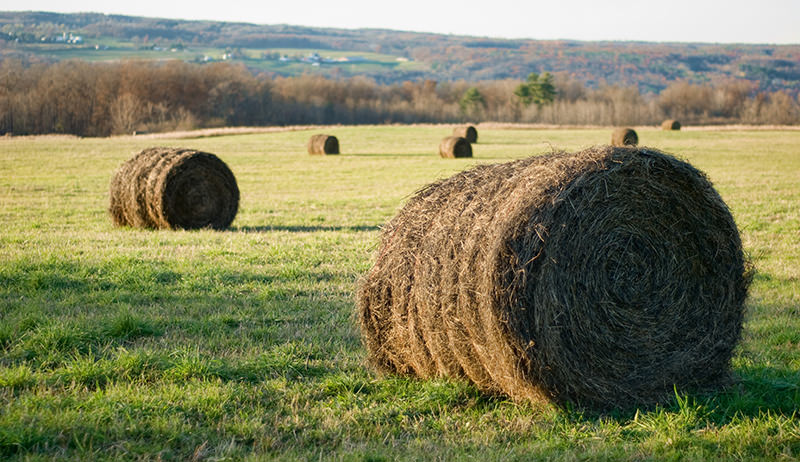Types of Hay for Beef Cattle
During the common cold wintertime months when pastures contain scant forage, hay is the typical nutrition for cattle, horses, sheep and goats.
Side by side to pasture, adept quality hay is the platonic feed. Yet, there are significant differences in the diversity, quality and availability of hay, which can make feeding your livestock a time-consuming chore.
Only with some planning, feeding hay during the winter months can exist a elementary and efficient alternative while waiting the return of spring'due south lush pastures.
Hay falls into several categories: grass, legume, mixed (grass and legume) and cereal grain harbinger (such as oat hay). Some of the more common grass hays include timothy, brome, orchard grass and bluegrass. In some parts of the state fescue, reed canary grass, ryegrass and Sudan grass are common.
In northern parts of the U.s.a., timothy is widely grown because information technology tolerates cold conditions and grows early in spring. It does not practise well in hot climates, however. In primal and southern parts of the land you are more apt to discover coastal Bermuda grass, brome or orchard grass because these tolerate heat and humidity ameliorate.
Cereal grain crops (particularly oats) tin can make good hay when cut while still light-green and growing, rather than waiting for the seed heads to mature for grain. There is always some risk of nitrate poisoning, however, if cereal grain hays are harvested after a spurt of growth following a drought menstruum. If you are considering purchasing this type of hay, information technology can be tested for nitrate content.

Legumes used for hay include alfalfa, various types of clover (such equally cherry, crimson, alsike and ladino), lespedeza, birdsfoot trefoil, vetch, soybean and cowpeas. Adept legume hay generally has a slightly college level of digestible energy, vitamin A and calcium than grass hay. Alfalfa may have twice the poly peptide and 3 times the level of calcium than grass hay. Thus alfalfa is often fed to animals that need more poly peptide and minerals.
Nutritional Value of Hay
The nutritional value of hay is related to leafage content. The leaves of grass hay have more nutrients and are more digestible when the found is immature and growing, and more cobweb when the constitute has reached full growth. Legume leaves, by contrast, do not accept the same structural function and don't alter much as the plant grows, but the stems become coarser and more fibrous.
Alfalfa stems, for case, are woody, serving as structural support for the plant. Leaf-to-stem ratio is the most important criterion in judging food quality in an alfalfa establish. The digestibility, palatability and nutrient values are highest when the constitute is young—with more leaves and less stems.
About 2¼ of the free energy and 3¼ of the protein and other nutrients are in the leaves of a provender plant (whether grass or legume). Coarse, thick-stemmed hay (overly mature) has more cobweb and less nutrition than immature, leafy hay with finer stems.
If buying alfalfa hay, yous'll want to know if it is outset, 2nd or tertiary cut (or afterward), and at what stage of growth it was harvested. Although there are differences between cuttings, quality is most important. Beginning-cut alfalfa tin can be stemmy, but just if it is too mature when harvested. Withal, weeds tend to appear in first-cutting alfalfa hay. 2d-cutting alfalfa usually has a higher stem-to-leafage ratio but is lower in crude poly peptide—about sixteen percentage on average. 3rd-cut alfalfa typically has a higher foliage-to-stem ratio because of slower growth during the cool part of the flavor. If buying grass hay, maturity at harvest will as well make a difference in its nutrient quality.
Early blossom alfalfa (cut before the blossoms open) has about 18 per centum crude poly peptide, compared with 9.8 pct for early bloom timothy (before seed heads fill), xi.4 percentage for early on bloom orchard grass, and lower levels for most other grasses. Alfalfa cutting at full bloom drops to 15.5 percentage rough protein, compared to half-dozen.9 percentage for late bloom timothy and vii.6 percent for late bloom orchard grass. Thus legume hay, cut early on, is more apt to meet the protein and mineral needs of young growing, pregnant or lactating animals than will many of the grass hays.
Fauna Feeding Tips
When changing an fauna'due south nutrition, exercise it gradually—especially when irresolute from a grass to a legume. Starting time by mixing the two hay types for several feedings, adding more of the new hay in each subsequent feeding.
The animals' digestive tracts must adjust to the different blazon of feed.
Changing to a legume hay all of a sudden tin make an animal sick, or cause a ruminant animal to bloat. Irresolute from grass hay to alfalfa all at one time tin change the environment in the rumen of cattle, sheep and goats and in the cecum of a horse (because of the shift in pH—the acid/base residual).
This can disrupt the microbes that aid the animals assimilate their feed.

Hay for Horses
Horses can do well on grass or alfalfa (or other legume) hay. Important factors to keep in mind for equus caballus hay are the nutritional needs of the animals (mature horses will not need loftier protein or calcium levels unless they are mares nursing foals), and the style the hay was harvested. If information technology was rained on after it was cut, baled as well green or too wet or too dry, information technology may not be safe to feed. Hay for horses should never contain dust or mold, as it may lead to coughing and respiratory bug. Some types of mold may cause colic or can cause a significant mare to abort.
Whether you feed grass or legume hay volition depend primarily on what is available in your surface area and your horse'southward particular nutritional needs. Skilful grass hay is the almost ideal feed for mature horses; it is the most natural feed, and contains the proper calcium/phosphorus ratio (preferably 1:1 to ii:1). For pregnant or lactating mares, or young growing horses, some legume hay added to the diet provides the boosted poly peptide and college levels of other nutrients needed. A mix of grass and legume hay frequently works well.
In some regions, information technology is hard to observe practiced grass hay. If you must employ alfalfa hay for all your horses, exist selective in the hay you choose. You may demand unlike qualities of hay for different horses—leafy hay for weanlings, for instance, and more than mature hay for adult horses that exercise non need such fine hay. Especially fine-stemmed, leafy alfalfa (rabbit hay or dairy hay) is besides rich and palatable for horses (they generally overeat on it) and does not have enough fiber content for proper digestion. Information technology is besides the most costly alfalfa. At the other extreme, overly stemmy alfalfa that is well past flower phase may be likewise coarse for horses.
In many geographic regions that become only two or three cuttings of alfalfa per season, start-cut alfalfa might be the preferred hay for horses. It is less apt to contain blister beetles (which are deadly if eaten), and information technology often has a niggling grass mixed in. Information technology too tends to take relatively coarse stems (supplying the fiber a horse needs for proper digestion) since information technology grows the fastest.
Later cuttings tend to grow more slowly and the stems are effectively and softer. These cuttings are too rich (too many nutrients per pound, with very fiddling fiber) for about horses, unless y'all are simply adding a petty bit of it to the diet of a young orphan foal or an older horse that has poor teeth and cannot chew stemmy hay.
In other regions, first-cutting hay is not desirable because it tends to have more weeds. If in that location is a long growing flavor, the 2nd and third cuttings will be coarser because they are growing the fastest, during the hottest weather. The later cuttings will accept the finest stems, growing more slowly during the cooler fall flavor. Every bit a general rule of thumb, grass hay is all-time for horses—alfalfa or other legume hay can exist an excellent feed to mix with grass hay for animals that demand more poly peptide. Alfalfa is too a adept winter feed because heat is created by digestion of protein, so a horse can go on warmer on a cold night.

Hay for Cattle
Cattle tin generally tolerate dustier hay than tin can horses, and can even eat a niggling mold without issues. Nevertheless, some types of mold may crusade ballgame in significant cows. The quality of the hay you lot feed will besides depend on whether you are feeding mature beef cattle, young calves or dairy cows. Mature beef cattle tin become past on rather obviously hay of any blazon merely lactating cows volition need acceptable protein. Proficient palatable grass hay, cut while withal green and growing, can be very adequate. Notwithstanding, if grass hay is coarse and dry (with little vitamin A or poly peptide), y'all'll demand to add some legume hay to the cattle's nutrition.
Young calves take tender mouths and cannot chew coarse hay very well—whether grass or alfalfa. They do best with fine, soft hay that'south cut before bloom stage; it not merely contains more nutrients, but is also much easier to eat.
Dairy cows demand the all-time hay—with the most nutrients per pound—since they are producing more milk than a beef moo-cow. Almost dairy cows will not milk adequately on grass hay, nor on stemmy, coarse alfalfa that contains few leaves. A dairy cow needs to be able to eat equally much as possible, and she will eat more fine, palatable alfalfa hay than coarse hay—and she will also get a lot more nutrition from it.
When hay costs rising, beef cattle can ofttimes get past eating a mix of straw and some type of protein. Straw (byproduct from harvest of oats, barley or wheat) provides energy, created past fermentation breakdown in the rumen. A modest amount of alfalfa, or a commercial protein supplement, tin provide the needed protein, minerals and vitamins. Always select good quality, clean harbinger when ownership it for feed. Oat harbinger is the most palatable; cattle like it quite well. Barley harbinger is not quite equally well liked, and wheat straw is least desirable equally feed. If feeding cereal grain hay (cut while nevertheless dark-green and growing, rather than at maturity, every bit straw), take it checked for nitrate levels to avoid nitrate poisoning. (Contact your local extension agent near testing.)
In cold weather condition, horses generate more body heat from digestion of extra protein, just cattle practise ameliorate if fed extra roughage (grass hay or straw) since they accept a larger "fermentation vat" (rumen). So during cold weather, you volition want to feed your cattle more roughage, rather than more legume hay.

Hay for Goats
Legume hays such as alfalfa, clover, vetch, soybean or lespedeza work very well for kids, every bit well as pregnant and lactating does. Mature goats do very well on a grass-legume mix and some grass hays, simply generally do not eat coarse grass hay; having pocket-sized mouths, goats do not like it. Most good equus caballus hay will piece of work fine for goats, because it will be palatable and free of grit and mold. If goats are fed coarse hay, they may eat the leaves but not the stems.
Equally browsers, goats eat a broad variety of plants when roaming free, and will eat some of the weeds and other undesirable plants that other animals will not. Because of this, they volition also eat weedy hay that might not be suitable for horses. Equally long every bit hay does not contain toxic plants, a few weeds in the hay can be acceptable when feeding goats.

Hay for Sheep
Sheep, like goats, prefer fine, leafy hay and will not swallow fibroid hay. Immature grass hay or leafy alfalfa is usually the best feed for sheep. Mature sheep can become past on good-quality grass hay, simply lambs do better with a legume—harvested while still growing then that information technology has effectively stems.
If fed on wet or muddy ground, sheep will mostly waste material a lot of hay; they will eat more of it when it is kept clean and dry out in a feeder, or some kind of feed bunk. When fed on dry out, well-sodded, snow covered or frozen basis, however, sheep will clean up fine hay better than cattle because of their smaller mouths and ability to pick upwardly the leaves. Some farmers go along sheep and cattle together when feeding hay, so the sheep tin swallow the finer leaves that cattle waste.
Caring for Your Pastures
Cheque your pasture regularly for poisonous plants and unwanted weeds. Remove and fire, or dispose of them in the trash—otherwise, you may see a render of these oft persistent and pesky plants.
Become specific advice on pasture care for your area from your canton or extension agent, or local agricultural expert.
Chemical weed sprays can be extremely harmful to livestock—their apply is not recommended by some vets. If you do opt for chemic weed command, be sure the product you cull is rubber for livestock and follow precisely the manufacturer's use instructions.
Only considering your animals live outdoors doesn't mean you're off the hook for manure removal. Either option it up or drag the pasture to spread the manure and then it will decompose more quickly. Regular manure management aids in parasite control and will as well outcome in more uniform grazing.

Selecting Hay for Feed
Hay quality tin vary greatly, depending on growing conditions and stage of maturity, weather and wet conditions at harvest. Factors that tin can affect nutritional value include plant species in the hay, fertility of soil, harvesting methods (whether the hay was conditioned or crimped to dry faster and lose less leaves and nutrients during drying) and curing time.
1 way to assess the maturity of alfalfa hay is the snap test. If a scattering of hay bends hands in your hand, its fiber content is relatively depression and information technology will be more than digestible than if the stems snap similar twigs.
The best manner to check hay is to open a few bales and inspect it closely. Expect at texture, maturity, color and leafiness. Bank check for weeds, mold, dust, discoloration due to weathering, heat due to fermentation of wet hay (if the cut hay was rained on before being baled and stacked), and foreign material in the bales such as rocks, sticks, baling twines or wire. If ingested, wire can cause "hardware" illness in cattle by perforating the gut and causing fatal peritonitis because they do non sort out foreign materials before eating.
Hay that has to exist redried due to rain volition exist irksome in colour—yellow or brown, rather than bright green. Only all hay tends to conditions considering the lord's day bleaches the exterior of the bales. You often cannot tell the quality of the hay by but looking at the outside of a bale. Even if the outer edge of a bale has faded from lord's day exposure and rain, the inside should all the same be green.
Use your nose as well equally your eyes. The smell of hay will requite a clue to quality. It should aroma good, not musty, sour
or moldy. The flakes should split easily from the bale and not be stuck together. Moldy hay, or hay that heated excessively after being baled, volition usually be heavy, stuck together and dusty. Practiced hay will be uniformly green and sugariness smelling, with no brown spots or moldy portions.
Unless you lot are ownership directly out of the field afterwards baling, try to buy hay that has been protected from conditions by a tarp or hay shed. Rain tin can ruin baled hay by causing mold. The acme and bottom layers of unprotected baled hay are particularly susceptible to mold since the top layer is exposed to the elements, and the lesser may have sabbatum on the ground, drawing moisture. Wet hay not only weighs more, adding to the cost, merely will likely exist moldy.

Storing Hay for Feed
Storing hay is not a problem if yous are buying only a few weeks worth at a time and can put a tarp over information technology, merely storage over several months requires more than protection to avert spoilage. Regardless of storage fourth dimension, you will need a style to keep information technology from getting wet or drawing moisture from the ground. A hay shed is platonic because yous can build upwards the floor with gravel for expert drainage and then the entire haystack is kept dry out.
If y'all don't accept any blazon of roof to put your hay nether, you lot can create a well-drained expanse (past building upwards the floor with gravel or wooden pallets) and cover the stack with tarps. If you create a ridgepole roof consequence (using a row of bales down the centre of the top of the stack, so that your tarp slopes off each way), the tarp will shed water better than a flat-topped stack. Besides, yous will be less apt to have spoilage from a leak in the tarp if the water can run off readily.
If you have a year's worth of hay stored, keep in heed that long storage time reduces nutritional levels of poly peptide and vitamin A. Always purchase hay that was harvested nether good conditions, then go on it dry out and out of the sunlight then it will keep better. Always stack it so that the oldest bales will exist used first.
Source: https://www.hobbyfarms.com/all-hay-is-not-equal-choose-your-livestocks-carefully/
Post a Comment for "Types of Hay for Beef Cattle"